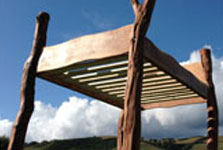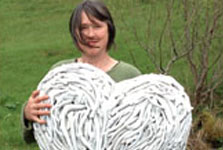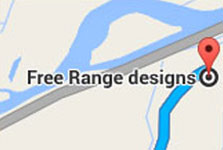General Information
Soakaways are a simple way of dispersing surface and storm water, and are also very effective for dispersing urine from composting toilets. The basic principle is that of a reverse well (i.e. a hole in the ground) that loses water rather than collecting water. Soakaways enable urine to be dealt with at the source rather than being collected and dealt with elsewhere.
The installation, design and construction of soakaways are governed by the Environment Agency. This document gives some suggestions and guidance regarding soakaways but the details and legalities of each soakaway will vary depending on its location.
Good practices regarding the positioning of a soakaway
Avoid siting a soakaway
• within 2 metres of a boundary
• within 5 metres of a road or highway
• within 10 metres of a watercourse of permeable drain
• within 15 metres of a building
• within 50 m from the point of abstraction of any groundwater supply
One of the first things to consider when choosing a site for a soakaway is the water table (saturation line), as areas with a high water table are unlikely to be suitable. This is defined as the upper level of the groundwater that is naturally held within the soil, sub-soil or bedrock.
Permeable sub-soils such as sands, sandy loams, along with permeable bedrock types, such as limestone, sandstone or chalk, are usually good news for soakaways, whereas hard, igneous rocks, such as granites and basalts, and heavy soils may mean a soakaway is not going to be feasible.
Where possible soakaways should be built on land lower than or sloping away from buildings. The soakaway should also be sufficiently far from any other drainage fields, drainage mounds or soakaways so that the overall soakage capacity of the ground is not exceeded.
Planning Permission
In normal domestic situations the formation of a soakaway does not require Planning Permission. If the site is situated in a “designated area” i.e. Conservation Area, Listed Building, National Park or Area of Outstanding Natural Beauty, Planning and other permissions may be required.
Three simple tests will determine the suitability of your potential site.
Test 1: Make sure your site is not in an area designated by The Environment Agency as Groundwater Source Protection Zone.
Test 2: Dig a Trial Site Assessment Hole at least 2 metres deep to make sure that the water table or bedrock never reaches to within 1 metre of the bottom of the soakaway pipe.
Test 3: Perform a Percolation Test to judge how quickly the soil absorbs 1mm of water. If the liquid soaks away too quickly or slowly then a soakaway will not be suitable.
The percolation test method
A percolation test should not be carried out during abnormal weather conditions.
- Excavate a hole 300 mm square and 300 mm below the proposed outlet from the soakaway.
- Bore the test hole vertically to the appropriate depth. Remove all loose debris.
- Fill the test hole with water to a depth of at least 300 mm. Allow to seep away overnight.
- Next day, refill the test section with water to a depth at least 300 mm. Observe the time, in seconds, for the water to seep away from 75% full to 25% full.
- Divide this time by 150 mm.
- The answer gives average time in seconds (Vp) required for the water to drop 1mm.
- Carry out the test at least 3 times, with at least 2 trial holes.
- The average figure from the tests should be taken.
- The average value of Vp should be between 12 and 100.
- The minimum value ensures liquids cannot percolate too rapidly into groundwater.
Please note that some Building Regulation Authorities will not accept your own readings from the test. Therefore, you may be required to contact a contractor to carry out the percolation test. Please check with your Local Authority.






